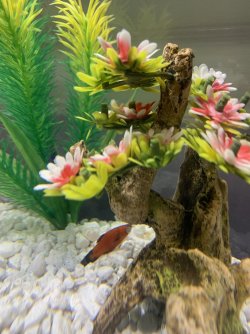birdie.katie
New Member
Tank size: 5 Gallons
Tank age: 2 weeks
Temperature: 72°
I have a spotted with a black tail and a solid red with black tail platy. Speedo (the red one) isn't being as active lately and he has a bubble around his eye. He can't see out of it and I'm not sure what to do. I got my two platys almost a week ago. I've never kept fish before, however my parents have and they're helping me. I also had an otocinclus when I first got them, but it died so my dad went back and got two more. Now they are all dead and I feel so bad and I don't understand what I did wrong so I don't know how to fix it. My tank sits at about 72°, and I have a heater to heat it back up. My filter is the one that came with the tank from PetSmart. I feed them a pinch each morning of the tropical fish flakes they told me to buy from the store. I'm really worried for lil' Speedo, and I feel really bad because I felt ready coming into this, but now I'm not so sure. I also don't know any of the nitrite nitrate levels or anything like that, so that could be the problem.
I attached pictures of my tank setup, the flakes, and two of Speedo's eye. My mom said tomorrow she would call the store and ask if they can help at all, but I'm not hopeful. If you have any advice it would be much appreciated.
-Katie




Tank age: 2 weeks
Temperature: 72°
I have a spotted with a black tail and a solid red with black tail platy. Speedo (the red one) isn't being as active lately and he has a bubble around his eye. He can't see out of it and I'm not sure what to do. I got my two platys almost a week ago. I've never kept fish before, however my parents have and they're helping me. I also had an otocinclus when I first got them, but it died so my dad went back and got two more. Now they are all dead and I feel so bad and I don't understand what I did wrong so I don't know how to fix it. My tank sits at about 72°, and I have a heater to heat it back up. My filter is the one that came with the tank from PetSmart. I feed them a pinch each morning of the tropical fish flakes they told me to buy from the store. I'm really worried for lil' Speedo, and I feel really bad because I felt ready coming into this, but now I'm not so sure. I also don't know any of the nitrite nitrate levels or anything like that, so that could be the problem.
I attached pictures of my tank setup, the flakes, and two of Speedo's eye. My mom said tomorrow she would call the store and ask if they can help at all, but I'm not hopeful. If you have any advice it would be much appreciated.
-Katie


